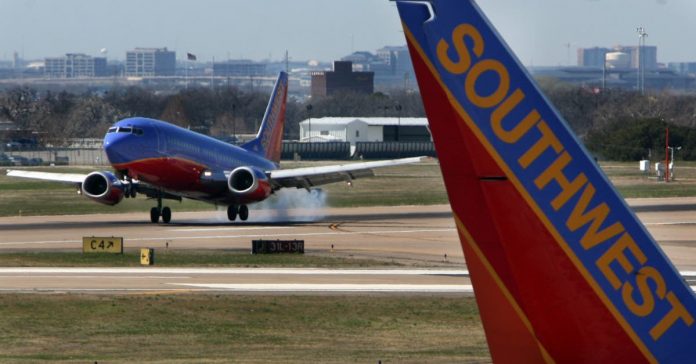The Wright Amendment was one of the most significant air travel laws on the books in the 21st century. The Wright Amendment governed air traffic in the Dallas-area and gave preference to the larger Dallas/Fort Worth International Airport over Dallas-Love Field. This hampered Southwest’s growth from Dallas-Love quite significantly before it was repealed, finally, in 2014.

The origins of the Wright Amendment
Back in the 1960s, Dallas was mainly served by Love Field. However, the aircraft was getting small and had limited potential for growth in the future. This led to the creation of Dallas/Fort Worth International Airport. The plan was to move existing carriers at Love Field to the new airport and reduce commercial service at Love Field.
However, Southwest Airlines was founded with intentions to operate out of Love Field. The airline received necessary permissions to fly out of Love Field. But then the lawsuits started in an attempt to get Southwest to move to Love Field. Those lawsuits proved unsuccessful, and Southwest won the right to fly in and out of Love Field.
Love Field, geographically, is closer to Dallas. Officials were concerned about flights at Love Field becoming more popular than the expensive Dallas/Fort Worth International and creating headaches for the new airport.

So, after the airline industry was deregulated in 1978, Texas representatives in the United States Congress pushed forward an amendment in 1980 to limit air traffic out of Love Field. This was known as the Wright Amendment.
What did the Wright Amendment say?
The Wright Amendment limited interstate air travel from Love Field. The only routes an airline could serve from the airports were to destinations in Louisiana, Arkansas, Oklahoma, New Mexico, and Texas, severely limiting growth out of the airport.
In addition, airlines could not sell connections out of Dallas with a stop in one of the neighboring states. So, for example, Southwest could not sell a flight from Dallas to Oklahoma City to Chicago. However, a passenger could purchase one ticket from Dallas to Oklahoma City and another ticket from Oklahoma City to Chicago on their own.
Airlines could not market the aforementioned options. However, passengers were free to book the options themselves. It would, unfortunately, offer some hassles.
Growing unease in Dallas
As Dallas/Fort Worth International continued to grow, thanks in part to the strong American Airlines hub, Dallas-Love faced additional restrictions. However, throughout the 1980s and 1990s, Dallas was a continued growing city, and strong concerns about limited airline competition out of Dallas led to sharp criticism of the Wright Amendment.
The original Wright Amendment allowed for 56-passenger flights to destinations outside of Texas. Few airlines took advantage of this. There was the short-lived Legend Airlines, which used all-first 56-seater jets to fly to points around the United States.
American Airlines, sensing some competition, even got in on the market per a report from News On 6. Using 56-seat Fokker 100s in an all-first configuration, the airline flew to Los Angeles and Chicago. Legend had flights to Washington, Los Angeles, and Las Vegas.

In 2004, Delta’s hub at DFW was significantly cut down, leaving American Airlines as the primary carrier in and out of Dallas, limiting competition. So, Southwest started a major push to repeal the Wright Amendment. In 2005, Missouri was added to the list of states allowing service out of Love Field.
The repeal of the Wright Amendment
By 2006, however, a repeal of the amendment was on the table. A compromise was struck that would see the full repeal of the amendment in 2014. This would allow any air carrier at Love Field to fly to points within the United States.
However, to keep American’s dominance in the Dallas-area, Love Field was reduced to a maximum capacity of 20 gates. This severely limits the number of airlines that can fly into and out of Dallas-Love. Currently, only Southwest, Delta, and Alaska fly out of Love Field. Alaska inherited its Love Field operations after a merger with Virgin America. Delta, meanwhile, flies out to Atlanta from Love Field.
Since the repeal of the Wright Amendment, Southwest had added a host of new flights out of the airport to Baltimore, Orlando, Chicago, New York, Minneapolis, Las Vegas and more, giving the carrier an extensive base out of the airport.

However, Dallas Love is only open for nonstop domestic flights. International flights can be sold through connections. The airport is still not equipped to handle large aircraft. Southwest only flies Boeing 737s; Delta flies in 717s and A320s; Alaska Airlines uses A320s, while SkyWest and Horizon (on behalf of Alaska) are operating E175s.
The post-repeal landscape
Post-repeal, Southwest maintains the lion’s share of passenger traffic. Data from the Bureau of Transportation Statistics shows that Southwest has over a 90% share of passengers. This is followed by SkyWest, which operates flights on behalf of Alaska Airlines, and then Delta. Between April 2019 and March 2002, Southwest carried over 14 million passengers to and from the airport. The next airline, SkyWest operating for Alaska Airlines, carried only 406,000 people during the same period of time to and from the airport.

Even in recent years, Love Field has not been without its conflict. Delta and Southwest have gotten in legal battles over gate space at Love Field. Delta remains interested in continuing to serve the airport while Southwest would rather add on more of its flights. In the court system, Delta has found some victories. Although, its Love Field operations remain restricted to flights to Atlanta’s Hartsfield Jackson International Airport.
As air travel becomes more competitive and DFW continues to fill up, there will likely be some push to allow Love Field to open up for more flights. While this would be met with some resistance, it is not impossible to envision Dallas opening up additional gate space out of Love Field.
Do you think Love Field should be expanded? Let us know in the comments!
[ad_2]
Source link

